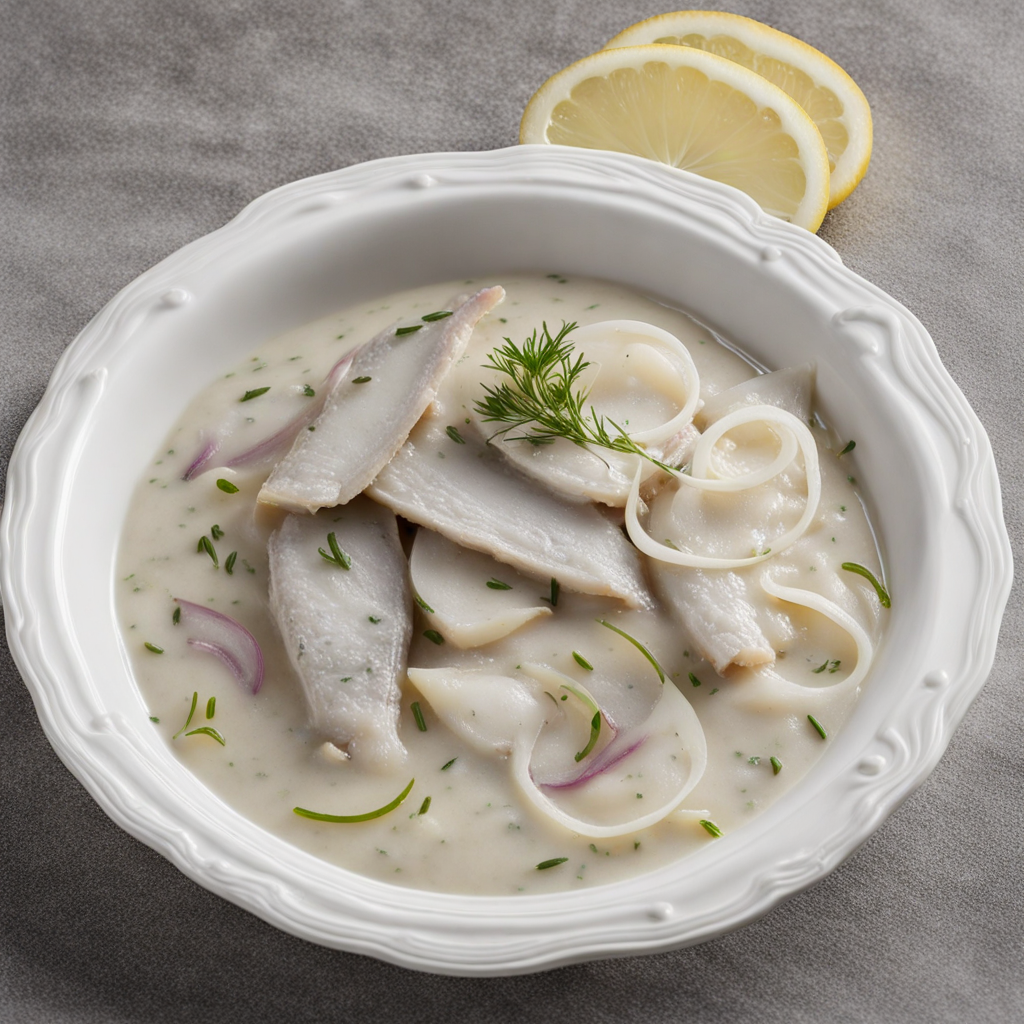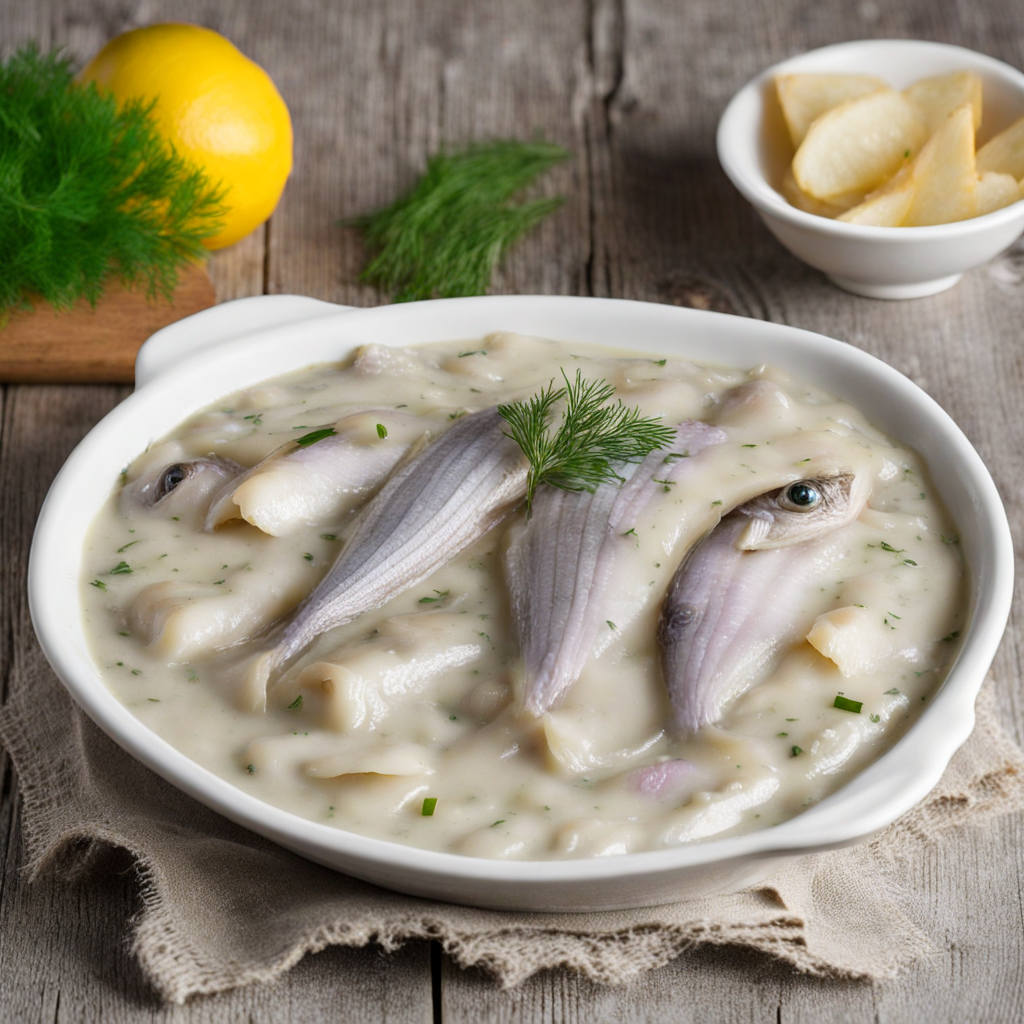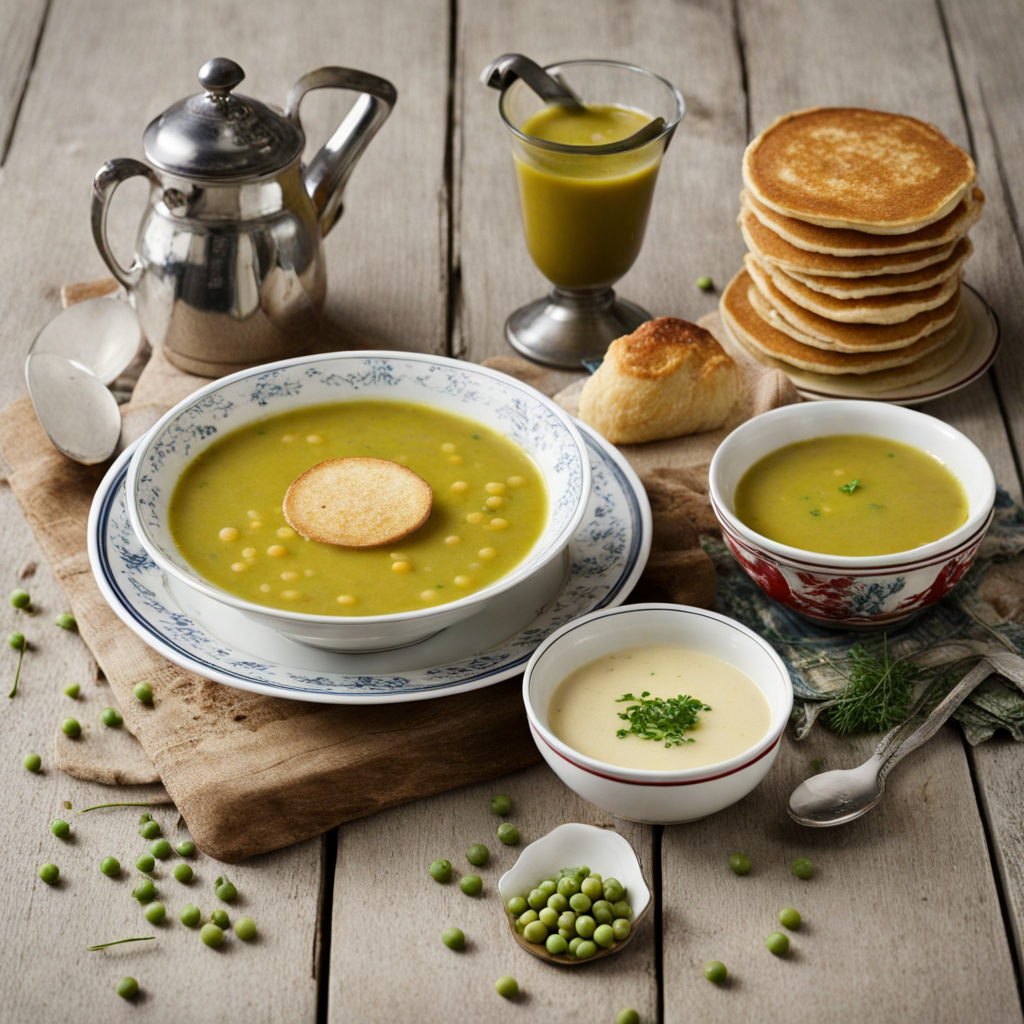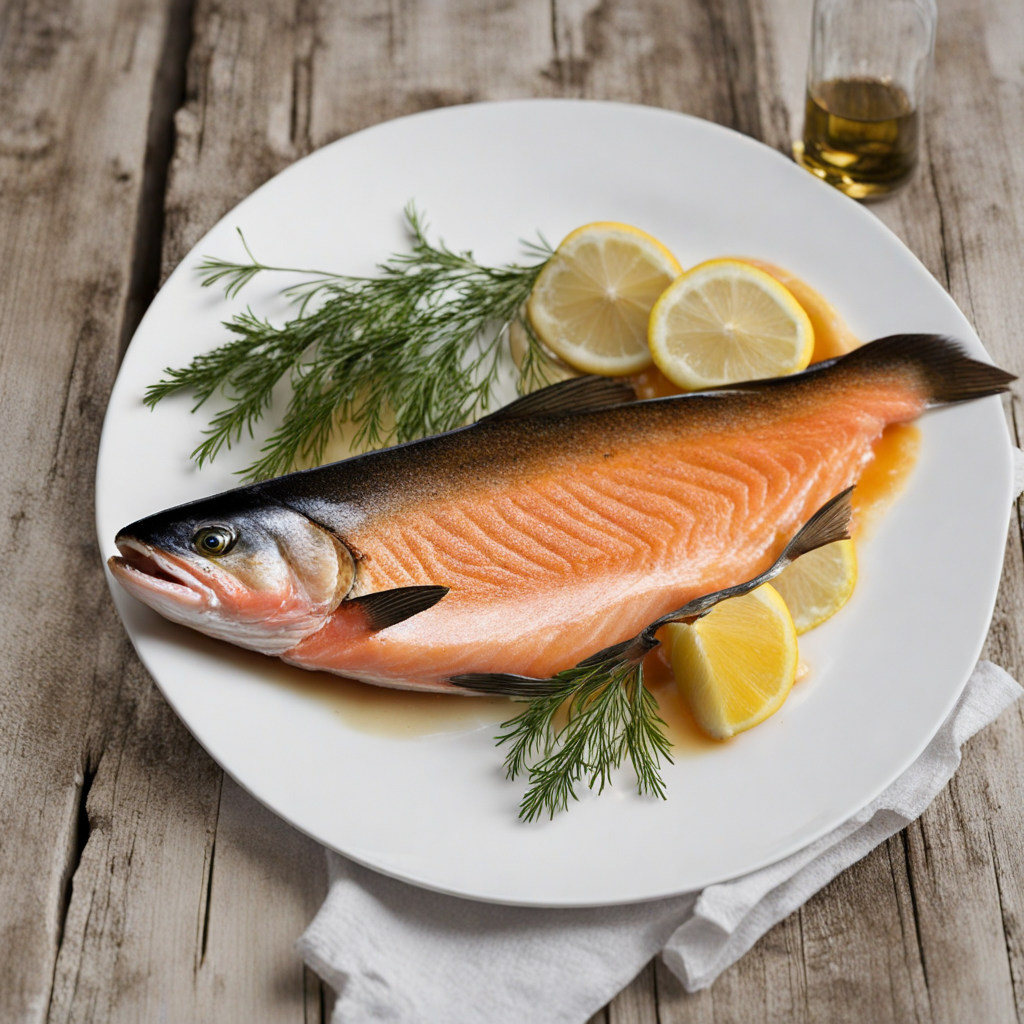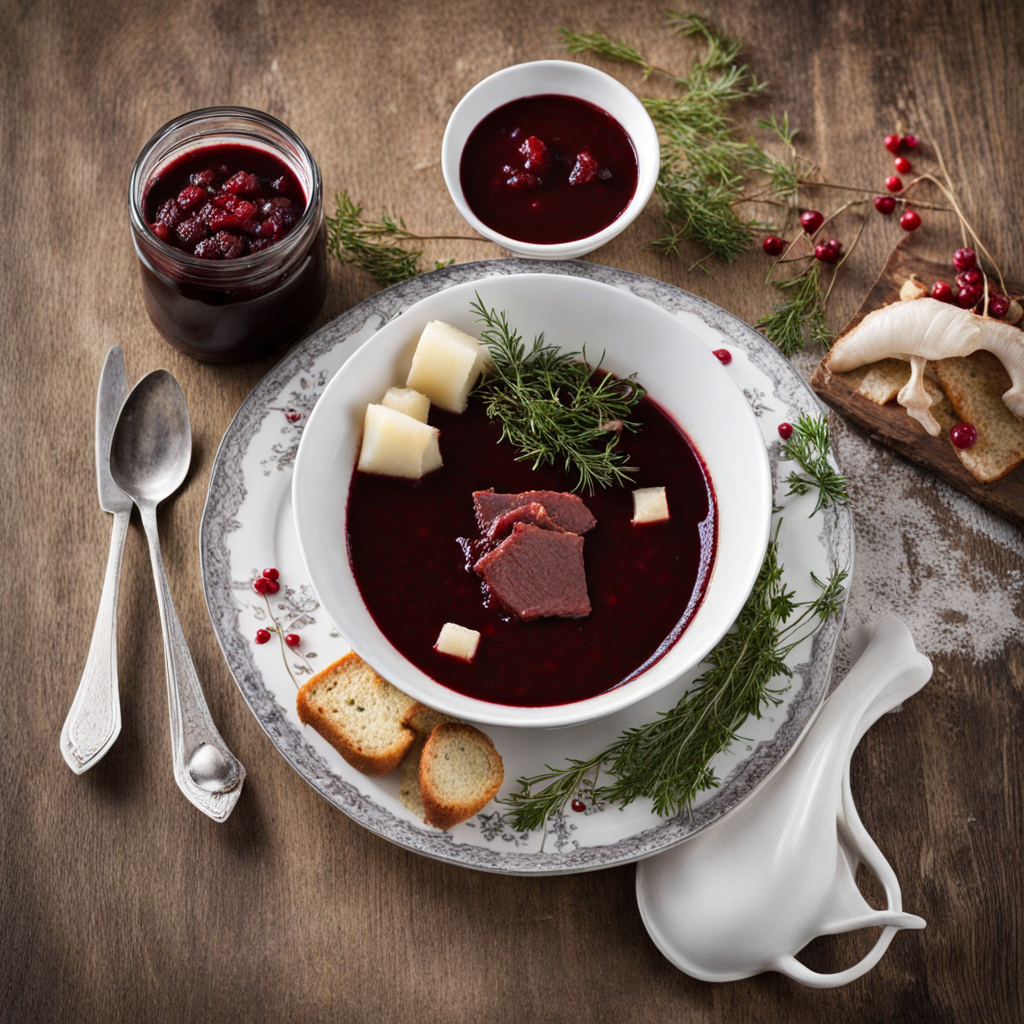Swedish Sour Cream and Onion Herring
Swedish Sour Cream and Onion Herring is a delightful dish that showcases the unique flavors of traditional Scandinavian cuisine. This dish features herring, a small, oily fish that is a staple in Swedish cooking. The herring is typically pickled to enhance its natural briny taste and then combined with a creamy, tangy sour cream dressing. The sour cream adds a rich, velvety texture, while the hint of acidity balances the fish's saltiness, creating a harmonious blend that awakens the palate. To elevate the flavor profile, finely chopped onions are incorporated, adding a subtle sweetness and a satisfying crunch. Often, fresh herbs like dill or chives are sprinkled on top, providing an aromatic finish that complements the fish beautifully. The combination of sour cream, onion, and herring results in a dish that is both refreshing and hearty, making it a popular choice in Swedish households, especially during festive occasions and smorgasbords. Served chilled, Swedish Sour Cream and Onion Herring is typically enjoyed on crispbread or alongside boiled potatoes, making it a versatile addition to any meal. Its unique combination of flavors makes it an intriguing option for those looking to explore new tastes and culinary traditions. Whether you're a seafood lover or just curious about Swedish cuisine, this dish is sure to offer a delightful experience that excites the senses.
How It Became This Dish
Gräddfil och Löksill: A Culinary Journey through Swedish Tradition In the heart of Sweden’s culinary landscape lies a dish that embodies the simplicity and richness of Nordic cuisine: Gräddfil och löksill, or sour cream with onion herring. This traditional dish, which pairs the creamy tang of gräddfil (sour cream) with the savory flavor of löksill (onion herring), offers a fascinating glimpse into Sweden's agricultural history, fishing heritage, and cultural practices surrounding food. #### Origins of Gräddfil och Löksill The origins of gräddfil date back to ancient times in Scandinavia, where dairy farming was a cornerstone of rural life. The term "gräddfil" itself translates to "cream film," referring to the layer of cream that forms on top of fermented milk. This practice of culturing milk can be traced back over a thousand years, with roots in Viking culture. The Vikings were known to have utilized the natural fermentation process to preserve milk and enhance its flavor, which laid the foundation for many dairy products still consumed today. Herring, on the other hand, has been a staple in the diets of coastal communities across Northern Europe for centuries. The fish's abundance in the Baltic Sea made it an accessible protein source, particularly during the long winters when fresh produce was scarce. The preservation of herring through pickling was a vital technique that allowed people to store this fish for months, making it a fundamental part of Swedish cuisine. The combination of gräddfil and löksill likely emerged as a way to elevate the humble pickled herring with a creamy, aromatic partner. The addition of onions not only provided flavor but also reflected the agricultural practices of the time, as onions were easy to grow and store through winter months. Thus, the dish symbolizes the harmony between the land and sea, showcasing the essential ingredients of Swedish culinary heritage. #### Cultural Significance Gräddfil och löksill is more than just a dish; it is steeped in cultural significance and tradition. In Sweden, herring is particularly prominent in festive occasions, such as Midsummer celebrations and Christmas feasts. During these gatherings, various preparations of herring, including löksill, take center stage, often served alongside other traditional dishes like potatoes, crispbread, and cured meats. The dish also reflects the Swedish concept of "lagom," which emphasizes balance and moderation. Gräddfil, with its rich texture, complements the salty, tangy flavor of pickled herring, creating a harmonious balance on the palate. This notion of balance extends beyond taste; it embodies the Swedish lifestyle, where simplicity and quality are valued over extravagance. In modern Sweden, gräddfil och löksill remains a beloved dish, often enjoyed during casual meals as well as festive occasions. It is a staple on the smörgåsbord, a traditional Swedish buffet that features a variety of dishes, encouraging communal dining and conversation. The dish’s enduring popularity speaks to its ability to connect people to their roots, reminding them of the past while remaining relevant in contemporary cuisine. #### Development Over Time As with many traditional dishes, gräddfil och löksill has evolved over time. In the 19th century, the Industrial Revolution brought significant changes to Swedish agriculture and fishing practices. Advances in refrigeration and transportation allowed for the mass production and distribution of food, leading to a broader availability of ingredients. This period also saw the rise of commercial pickling processes, which standardized the production of pickled herring and made it more accessible to the general population. In the 20th century, globalization began to influence Swedish cuisine, introducing new flavors and techniques. However, many Swedes remained committed to their culinary heritage, and traditional recipes for gräddfil och löksill continued to be passed down through generations. Contemporary chefs have embraced this dish, often experimenting with flavors while retaining the essence of the original. Today, gräddfil och löksill can be found in various forms, from artisanal preparations in high-end restaurants to home-cooked meals. While the classic version uses pickled herring, sour cream, and onions, modern interpretations might incorporate additional ingredients such as dill, mustard, or even citrus zest, reflecting a fusion of traditional and contemporary culinary practices. #### Pairing with Other Dishes Gräddfil och löksill is typically served with rye bread or crispbread, which has a long history in Sweden. The nutty flavor of the bread complements the dish’s richness, making it a satisfying combination. Potatoes, particularly boiled or roasted, are also a common side, as they provide a hearty and grounding element to the meal. During festive occasions, gräddfil och löksill is often accompanied by other pickled herring varieties, such as senapssill (herring in mustard sauce) or sillsallad (herring salad), creating a vibrant display of flavors and textures on the table. This communal approach to dining reinforces the social aspect of Swedish meals, where sharing and enjoying food together is a cherished tradition. #### Conclusion Gräddfil och löksill stands as a testament to Sweden’s rich culinary heritage, reflecting the deep connection between the land, sea, and the people who inhabit it. From its ancient origins rooted in dairy farming and fishing to its modern-day interpretations, this dish encapsulates the essence of Swedish culture. It serves as a reminder of the importance of tradition, community, and the simple joys of food. As Sweden continues to evolve, gräddfil och löksill will likely remain a cherished dish, bridging the gap between past and present, while inviting future generations to savor the flavors of their heritage. Whether enjoyed at a festive gathering or a casual family meal, the dish remains a delicious representation of Swedish identity and culinary ingenuity, embodying the spirit of lagom and the beauty of simplicity.
You may like
Discover local flavors from Sweden


